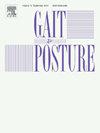Effects of external ankle braces on kinematics and kinetics of the lower limb during the cutting maneuver in healthy females
IF 2.2
3区 医学
Q3 NEUROSCIENCES
引用次数: 0
Abstract
Background
To explore if lace-up ankle brace and hinged ankle brace affect the kinematics and kinetics of the lower limbs during a cutting maneuver.
Methods
Twenty healthy females performed a 45° cutting maneuver with different ankle braces. Ground reaction force, lower-limb joint angles and moments were compared among different ankle braces.
Results
Wearing hinged ankle brace significantly increased maximal knee valgus angle than lace-up and no brace conditions (0.7° [p = 0.011] and 0.6° [p = 0.029], respectively). Wearing hinged and lace-up ankle braces significantly increased maximal knee internal rotation angle (1.58° [p ≤ 0.001] and 1.30° [p = 0.020], respectively) and decreased maximal ankle inversion angle (3.04° [p ≤ 0.001] and 1.76° [p = 0.013], respectively). A considerable difference in kinetics was observed only in the maximal ankle eversion moment, which was higher in the hinged condition than the lace-up (p = 0.010) or no brace (p = 0.023) condition.
Conclusion
Wearing an hinged or lace-up ankle brace may reduce the risk of ankle sprain in females during cutting maneuvers. Ankle brace appears to have upstream effects on the knee, which may have injury implication.
求助全文
约1分钟内获得全文
求助全文
来源期刊

Gait & posture
医学-神经科学
CiteScore
4.70
自引率
12.50%
发文量
616
审稿时长
6 months
期刊介绍:
Gait & Posture is a vehicle for the publication of up-to-date basic and clinical research on all aspects of locomotion and balance.
The topics covered include: Techniques for the measurement of gait and posture, and the standardization of results presentation; Studies of normal and pathological gait; Treatment of gait and postural abnormalities; Biomechanical and theoretical approaches to gait and posture; Mathematical models of joint and muscle mechanics; Neurological and musculoskeletal function in gait and posture; The evolution of upright posture and bipedal locomotion; Adaptations of carrying loads, walking on uneven surfaces, climbing stairs etc; spinal biomechanics only if they are directly related to gait and/or posture and are of general interest to our readers; The effect of aging and development on gait and posture; Psychological and cultural aspects of gait; Patient education.
 求助内容:
求助内容: 应助结果提醒方式:
应助结果提醒方式:


